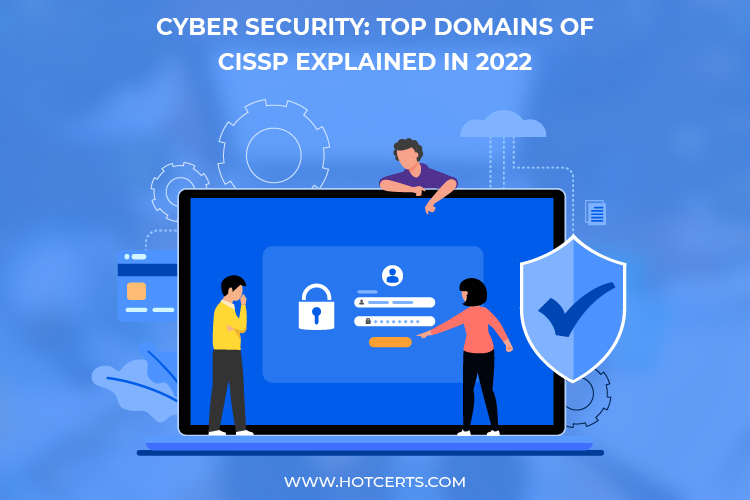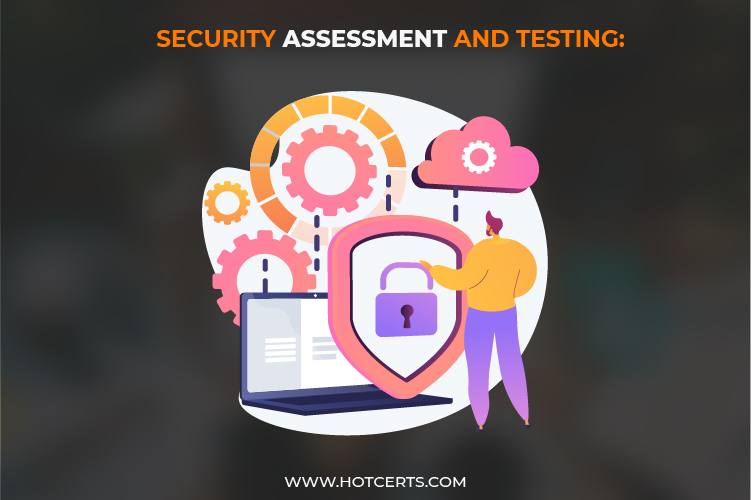CISSP (Certified Information Systems Security Professional) is the highest level and most searched data security qualification for demonstrating Cyber security education. It verifies the specialists’ knowledge and expertise in developing and managing safety solutions for the company. The CISSP is an eight-domain compilation that includes all types of data security and explains the CISSP (Certified Information Systems Security Professional) domains. To obtain the certificate, a candidate must know every part.
When you choose the certification of CISSP, below are the eight domains you will study in this certification. So, if you’d like to know the details of these domains, read this article.
Software Development Security:
- Developing and implementing safe coding rules and standards
- Effect on security assessment
- Software security impact
- In the developing phase, implementing safety measures
- All through SDLC, learn and apply security
All these things happen in this domain, and these are the things that you should know if you want to get the certification of CISSP. Developing and implementing safe security standards in this domain can make the system more secure and safe. Security of Software is vital because if the Software does not inspire confidence, it can never get a good reputation in the market which means no sales. So, software development security is one of the domains you need to learn in CISSP.
Security Operations:
This area provides visibility into the planning process and inspections, tracking, and safety measures. The following are the primary issues covered in this domain:
Handling the safety and security of employees
- Taking care of physical safety
- Training and preparation for business operations
- Basic security assessment
- Backup and Recovery Procedures and Testing
- Plans and actions are being implemented and tested.
- Management of disasters
- Knowing how to protect natural resources
- Identification, installations, and management of assets
- Creating a tracking and control system
Types of investigations have general standards:
Investigative Procedures
It would help if you learned all these things in this domain of CISSP (Certified Information Systems Security Professional) to complete your certification. Security operations are essential because you can’t make the security of your system robust without them.
Security Assessment and Testing:
This domain covers the design, operation, monitoring, and auditing of information systems. The following are the essential issues that fall within this domain:
Optimizing safety audits
- Evaluating test results and putting up a report
- Collecting safe information, assessing security controls, and testing safety controls
- Possible solutions for local, public, and third-party inspections
So, in security assessment and testing, you need to learn everything we mention above. Auditing is significant in this domain because it is suitable for the betterment of the system. In auditing, the third party gives an honest analysis of the system. And the people from the inside of your corporation don’t involve in it. The third-party critique will be constructive in providing an honest review. So, security assessment and testing is another domain of CISSP (Certified Information Systems Security Professional) that you should learn to get this certification done.
Identity and Access Management:
The characteristics of user accessibility within an organization are covered in this domain area. The following are the main issues covered in this domain:
Lifecycle of identification and accessibility
- Putting the Authentication System in Place
- As a third-party provider, recognizing and implementing identities is crucial.
- Managing and monitoring device, user, and company certification and authentication
- Keeping track of who has logical and physical control of assets
- You need to learn and understand all these things in this domain because you can’t get certification without that.
Communications and Network Security:
Network security elements, concepts, and transmission implementation are all covered in this area. The following are the primary subjects addressed by this domain:
Keeping communication lines secure according to the plan
- Putting together safe system components
- Applying and protecting network design and implementation concepts
Security Architecture and Engineering:
This area covers many aspects of organizational security architectural design guidelines, concepts, and safe abilities evaluation. Below you can read the primary topics covered in this domain:
- Applying safety principles and procedures to the site and putting them in place
- Network designers, layouts, smartphone systems, web-based structures, and integrated devices have weaknesses that must be identified and handled.
- Ideas of encryption for enhancing the information security
- Security models are built on a foundation of basic concepts.
- Safe design patterns are used in engineering applications.
Security architecture and engineering is another domain of CISSP (Certified Information Systems Security Professional). So, you need to know all these things in this domain because you’ll not get certification without knowing these things.
Asset Security:
The sensitive data and standards for properties within an organization are covered under this domain. The following are the essential topics in Asset Security:
Dealing
- Putting in place data security measures
- Preservation of assets
- Privacy protection
- Information and resources must be identified, classified, and owned
Suppose you want to learn about this domain. In that case, you should choose CISSP (Certified Information Systems Security Professional) certification because all the things we mention here are included.
Security and Risk Management:
Another domain of the CISSP (Certified Information Systems Security Professional) qualification is the biggest and has the most significant percentage of points. There are numerous essential features of this domain:
- Perform security teaching, education, and information campaigns.
- Incorporating risk-based methodologies into logistics
- Threat modeling ideas and approaches
- Principles of managing risk must be understood and applied.
- Creating safety standards and procedures for employees
- Create a strategy, scope, and effect for your business continuity needs.
- On a worldwide scale, regulatory and legal concerns relating to information protection.
- Professional values are involved.
- Compliance needs are assessed.
- Putting security management ideas into practice
- Authenticity, secrecy, and accessibility are all aspects that should consider.
You need to learn and have knowledge of all these things to get the certification of CISSP. So, security and risk management is another domain of this process that you must know.
Here we mention the top 8 domains of CISSP (Certified Information Systems Security Professional) and explain these domains. There are more of them, but we only enlist the top 8 ones to help people who want to know about this course and the detail of certification. You can choose any of these domains to get your Certified Information Systems Security Professional – CISSP certification done.
FAQs about the CISSP Exam
To pass the CISSP certification, you need to clear the CISSP exam. You need to know many things about this exam if you’d like to give it. So, if you have some questions regarding this exam, the below portion will be helpful for you.
How Is This Exam Changing?
The CISSP’s material has been updated to reflect the more pressing concerns cyber security experts face today and the most refined techniques for dealing with these. Therefore, a test that most properly shows the technological and managerial competency needed for a quantity of information safety experts to plan, construct, execute, and monitor a firm’s cyber security program in a changing threat landscape has been developed. We altered several of the domains’ information due to the material update to correctly identify the subjects. Read our CISSP (Certified Information Systems Security Professional) domain information mentioned above to learn about the test domain and subdomain modifications.
What Are the Reasons to Made Changes in The Exam of CISSP?
(ISC)2 has a responsibility to its users to keep their qualifications up to date. Such improvements result from a disciplined, systematic process (ISC)2 used to upgrade its certification tests regularly. This method guarantees that the trials and associated continuing medical education standards cover the topics related to today’s modern practicing data security experts’ tasks and duties.
Do Such Changes Contain an Impact On The CISSP Expertise Necessity?
No, an applicant for the CISSP (Certified Information Systems Security Professional) must have the least five years of paid whole job experience in two or more of the CISSP’s eight domains. This experience is essential because you can never fulfill the requirements if you don’t have this experience. So, the changes in the exam don’t have any impact on the CISSP expertise necessity.
Will I Be Fully Ready to Take the Exam Objectives Without Further Studying If I Studied for The CISSP Examination Using Content Focused On the Present Domains?
These tests depend on expertise and feature topics that can never teach solely through study. When you already got experience in the CISSP (Certified Information Systems Security Professional) areas and think you have adequately researched these domains, you must feel excited about the opportunity to complete and clear the examination. As a result, it cannot ensure that you can become successful in the test.
Would This Affect the Number of Questions or The Amount of Time It Takes to Pass The CISSP Examination?
No, irrespective of whether the examination is in the CAT or the linearly set style, the modifications will not affect the number of questions on the CISSP examination. The CISSP (Certified Information Systems Security Professional) CAT would consist of 100m to 150 questions with a three-hour time restriction. The CISSP sequential structure would maintain 250 questions with a six-hour time restriction.
What Languages Will the Updated CISSP (Certified Information Systems Security Professional) Examination Be Offered?
There are several languages such as Korean, Chinese, Japanese, Spanish, French, and some more than the updated CISSP examination is offered.
More things to know:
The CISSP CBK assesses your knowledge of the eight domains listed above. Every part would provide you with the information to pass an examination, flourish in this field, and final performance operational activities.
The (ISC)2 CISSP (Certified Information Systems Security Professional) examination uses compiled assessments; every other language uses straight, fixed-form tests. It would help if you searched a little to understand much more about this exam’s style, complexity, and timing. You can find everything on your browser, and you can know all you’d like to know.
Conclusion:
There are so many things that people should know about CISSP (Certified Information Systems Security Professional) certification before applying for it. There are 8 top domains that you must know about, and you need to have at least five years of working experience in at least two or more fields to get this certification done. Also, there are some FAQs that we mention in this article regarding this certification, and these FAQs will be very helpful for you in getting complete knowledge about this certification.
So, please read this article and learn about CISSP (Certified Information Systems Security Professional) certification and its top domains to get help and increase your knowledge. Comment below if you still have any questions related to CISSP certification. Our professional team will assist you accordingly!




